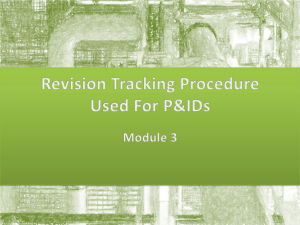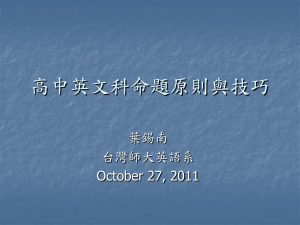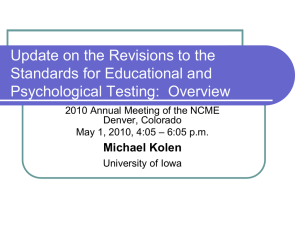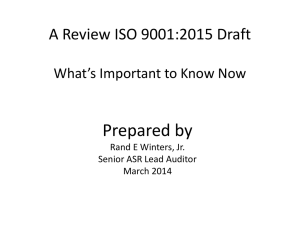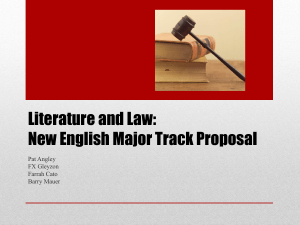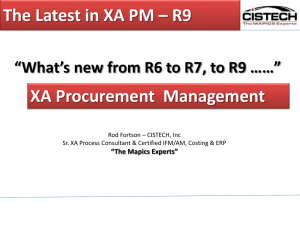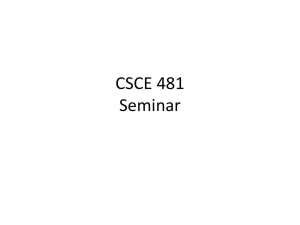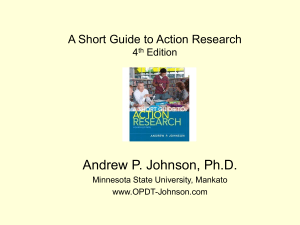Review of AERA/APA/NCME Test Standards Revision and Students
advertisement
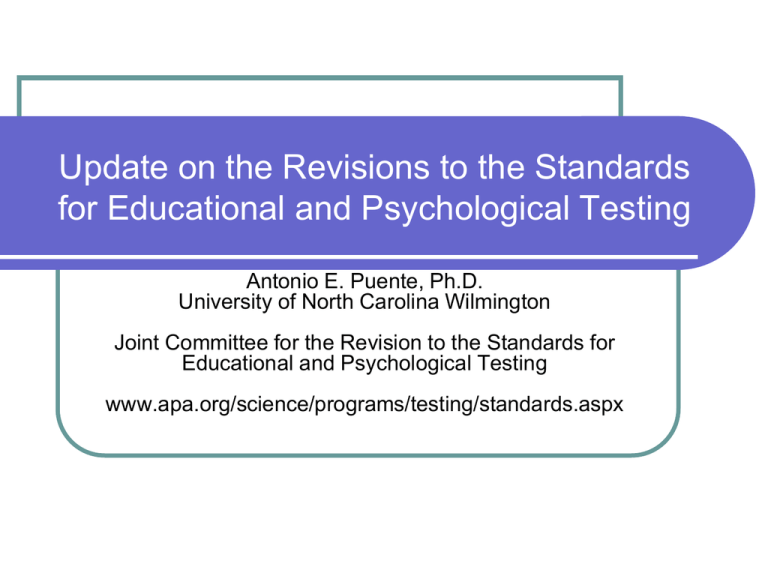
Update on the Revisions to the Standards for Educational and Psychological Testing Antonio E. Puente, Ph.D. University of North Carolina Wilmington Joint Committee for the Revision to the Standards for Educational and Psychological Testing www.apa.org/science/programs/testing/standards.aspx Mission & Brief History • “The purpose for publishing the • standards is to provide criteria for the evaluation tests, testing practices, and the effects of tests use”. (1999) Established in 1954; revised in 1955, 1966, 1999 and currently (2009-2011) • American Psychological Association, American Educational Research Association, National Council on Measurement in Education Update on Revisions to the Test 4/9/2015 Standards 2 Update on the Revisions to the Standards for Educational and Psychological Testing: Overview of the Revision Process Scope of the Revision • Based on comments each organization • received from invitation to comment Summarized by the Management Committee in consultation with the CoChairs • Wayne Camara, Chair, APA • Suzanne Lane, AERA • David Frisbie, NCME 4/9/2015 Update on Revisions to the Test Standards 4 Joint Committee Members • Lauress Wise, Co Chair, HumRRO • Barbara Plake, Co Chair, University of Neb. • Linda Cook, ETS • Fritz Drasgow, University of Illinois • Brian Gong, NCIEA • Laura Hamilton, Rand Corporation • Jo-Ida Hansen, University on MN • Joan Herman, UCLA 4/9/2015 Update on Revisions to the Test Standards 5 Joint Committee Members • Michael Kane, ETS • Michael Kolen, University of Iowa • Antonio E. Puente, UNC-Wilmington • Paul Sackett, University of MN • Nancy Tippins, Valtera Corporation • Walter (Denny) Way, Pearson • Frank Worrell, Univ of CA- Berkeley 4/9/2015 Update on Revisions to the Test Standards 6 Five Identified Areas for the Revisions • Access/Fairness • Accountability • Technology • Workplace • Format issues 4/9/2015 Update on Revisions to the Test Standards 7 Timeline • First meeting January, 2009 • Three year process for completing text of • • • revision Release of draft revision following December 2010 JC meeting Open comment/Organization reviews Projected publication Summer, 2012 4/9/2015 Update on Revisions to the Test Standards 8 Anticipated Review Process • Draft released December 2010 • 90 Day (+/-) Review Period • Public Portal for Submitting Comments • Sponsoring Organizations with Publicize • Opportunity for Comments Committee will Summarize Key Issues from Reviews and Provide Response(s) 4/9/2015 Update on Revisions to the Test Standards 9 Publication Options • Management Committee responsibility • Goal is for electronic access • Pursuing options for Kindle, etc. • Concerns about retaining integrity and financial support for future revision efforts May 1, 2010 4/9/2015 Update on Revisions to the Test Standards 10 Update on the Revisions to the Standards for Educational and Psychological Testing: Fairness for Diverse Populations 1999 Approach • Standards related to fairness appear • throughout many chapters Concentrated attention in: • Chapter 7: Fairness in Testing and Test Use • Chapter 8: Rights and Responsibilities of Test Takers • Chapter 9: Testing Individuals of Diverse Linguistic Backgrounds • Chapter 10: Testing Individuals with Disabilities 4/9/2015 Update on Revisions to the Test Standards 12 Committee Charge • • • Five elements of the charge focused on accommodations/modifications • • • • • 4/9/2015 Impact/differentiation of accommodation and modification Appropriate selection/use for English learners (ELs) and examinees with disabilities (EwD) Attention to other groups, e.g., pre-K, older populations Flagging Comparability/validity of accommodated scores One element focused on adequacy and comparability of translations One element focused on Universal Design Update on Revisions to the Test Standards 13 Revision Response • • • • • • • 4/9/2015 Fairness is fundamental to test validity: include as foundation chapter Fairness and access are inseparable Same principles of fairness and access apply to all individuals and regardless of specific subgroup From three chapters to a single chapter that describes core principles and standards Examples drawn from ELs, EwD, and other groups (young children, aging adults adults, etc) Comments point to applications for specific groups More particular standards retained where appropriate (e.g., test translations) Update on Revisions to the Test Standards 14 Overview to Fairness Chapter • Section I: General Views of Fairness • Section II: Threats to the Fair and Valid Interpretations of Test Scores • Section III: Minimizing Construct Irrelevant Components Through the Use of Test Design and Testing Adaptations • Section IV: The Standards 4/9/2015 Update on Revisions to the Test Standards 15 Four Clusters of Standards 1. 2. 3. 4. 4/9/2015 Use test design, development administration and scoring procedures that minimize barriers to valid test interpretations for all individuals. Conduct studies to examine the validity of test score inferences for the intended examinee population. Provide appropriate accommodations to remove barriers to the accessibility of the construct measured by the assessment and to the valid interpretation of the assessment scores. Guard against inappropriate interpretations, use, and/or unintended consequences of test results for individuals or subgroups. Update on Revisions to the Test Standards 16 Update on the Revisions to the Standards for Educational and Psychological Testing: Other Issues Other Issues in Committee Charge • Increased use of tests for accountability • Impact of technology on testing • Format and style issues 4/9/2015 Update on Revisions to the Test Standards 18 Increased Use of Testing for Accountability • Use of tests for accountability has expanded • • • • Most notably in education but also in other areas such as behavioral health Facilitated by increasing availability of data and analysis tools Recent and impending federal and state initiatives will likely lead to further expansion Use of test scores in policy and program evaluations continues to be widespread • May 1, 2010 4/9/2015 Reinforced by groups that fund and evaluate research (e.g., IES, What Works Clearinghouse) Update on Revisions to the Test Standards 19 Organization of Accountability Material • Chapter on policy uses of tests focuses on use of aggregate scores for accountability and policy • Chapter on educational testing addresses student-level accountability (e.g., promotional gates, high school exit exams) and interim assessment • Validity, reliability, and fairness standards in earlier chapters apply to accountability testing as well May 1, 2010 4/9/2015 Update on Revisions to the Test Standards 20 Impact of Technology • Technological advances are changing the way • • tests are delivered, scored, interpreted and in some cases, the nature of the tests themselves The Joint Committee has been charged with considering how technological advances should impact revisions to the Standards As with the other themes, comments on the standards that related to technology were compiled by the Management Committee and summarized in their charge to the Joint Committee 4/9/2015 Update on Revisions to the Test Standards 21 Key Technology Issues Included in our Charge • • • Reliability & validity of innovative item formats Validity issues associated with the use of: • • • 4/9/2015 Automated scoring algorithms Automated score reports and interpretations Security issues for tests delivered over the internet Issues with web-accessible data, including data warehousing Update on Revisions to the Test Standards 22 Reliability & Validity of Innovative Item Formats • • • What special issues exist for innovative items with respect to access and elimination of bias against particular groups? How might the standards reflect these issues? What steps should the standards suggest with regards to “usability” of innovative items? What issues will emerge over the next five years related to innovative items/test formats that need to be addressed by the standards? 4/9/2015 Update on Revisions to the Test Standards 23 Automated Scoring Algorithms • • • What level of documentation/disclosure is appropriate and tolerable for automated scoring developers/vendors? What sorts of evidence seem most important for demonstrating the validity and “reliability” of automated scoring systems? What issues will emerge over the next five years related to automated scoring systems that need to be addressed by the standards? 4/9/2015 Update on Revisions to the Test Standards 24 Automated Score Reports and Interpretation • • Use of computer for score interpretation “Actionable” reports (e.g., routing students and teachers to instructional materials and lesson plans based on test results) • • 4/9/2015 Documentation of rationale Supporting validity evidence Update on Revisions to the Test Standards 25 Format Issues • Consideration of ways to identify of “Priority • • Standards” More parallelism between chapter • Tone • Complexity • Technical language Organization of Chapters May 1, 2010 4/9/2015 Update on Revisions to the Test Standards 26 Possible Ways to Identify “Priority Standards” • Clustering of Standards into thematic • • topics Over-arching Standards/ Guiding Principles Application Chapters • Connection of standards to previous standards May 1, 2010 4/9/2015 Update on Revisions to the Test Standards 27 Organization of Chapters • 1999 Testing Standards • Three sections • Foundation: Validity, Reliability, Test Development, • • May 1, 2010 4/9/2015 Scaling & Equating, Administration & Scoring, Documentation Fairness: Fairness, Test Takers Rights and Responsibilities, Disabilities, Linguistic Minorities Applications: Test Users, Psychological, Educational, Workplace, Policy Update on Revisions to the Test Standards 28 Possible New Organization Section 1: Core Principles Validity, Reliability, Fairness Testing Operations Test Design and Development, Scaling & Equating, Test Administration & Scoring, Documentation, Test Takers, Test Users Section 2 : Applications Psychological, Educational, Workplace, Update on Revisions to the Test Policy and Accountability May 1, 2010 4/9/2015 Standards 29 Additional Important Information • Documentation • Third Party Observers • Standardized Administration/Scoring • Technicians • Supervision • Diverse Populations • Norms 4/9/2015 Update on Revisions to the Test Standards 30 Feedback Requested • Feedback Information • Web-based • Necessary due to its impact • Feedback Timetable • Comment period• Revision period- Publication expected- 2012 (APA) 4/9/2015 Update on Revisions to the Test Standards 31
